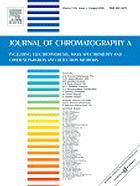|
Literature / Source Database:
Journal of Chromatography, Part A
| Title (short) |
J. Chromatogr. A |
| CODEN |
JCRAEY |
| Languages |
English |
| First year |
1993 |
| Impact factor |
3.858 |
| Editor |
J.G. Dorsey, R.W. Giese, C.F. Poole, M.-L Riekkola, P.J. Schoenmakers, V. Schurig, N. Tanaka, S. Terabe, P.R. Haddad |
|
|

|
Status
active
Indexing
Analytical Abstracts, BIOSIS, Biochemical Abstracts, Chemical Abstracts, Chemical Titles, Chromatography Abstracts, Current Contents/Life Sciences, Current Contents/Physics, Chemical, & Earth Sciences, Deep-Sea Research/Part B: Oceanographic Literature Review, EMBASE, Elsevier BIOBASE, MEDLINE®, Mass Spectrometry Bulletin, PASCAL/CNRS, Referativnyi Zhurnal, Research Alert, Science Citation Index, Scopus
Predecessor
Subject

Source type
Journal
Publisher
ISBN ISSN
0021-9673
First volume
1
Last volume
1615+
Publish city
Amsterdam
Homepage
| Resources |
|
Availability |
|
|
|
|
|
| Text PDF |
 |
free access |
 |
| Text Html |
 |
for subscriber |
 |
| References |
 |
not available |
 |
| Abstracts |
 |
|
|
| TOC |
 |
|
|
|
|
|
|

Description
The Journal of Chromatography A provides a forum for the publication of original research and critical reviews on all aspects of fundamental and applied separation science. The scope of the journal includes chromatography and related techniques, electromigration techniques (e.g. electrophoresis, electrochromatography), hyphenated and other multi-dimensional techniques, sample preparation, and detection methods such as mass spectrometry. Contributions consist mainly of research papers dealing with the theory of separation methods, instrumental developments and analytical and preparative applications of general interest. Journal of Chromatography A welcomes the submission of research papers which report on studies concerning the development of new and significant advances in separation science. Manuscripts detailing fundamental research on all aspects of separation science theory and methodology are especially encouraged. In determining the suitability of submitted articles for publication, particular scrutiny will be placed on the degree of novelty and significance of the research and the extent to which it adds to existing knowledge in separation science. Papers describing the use of routine separation methods or straightforward extensions of these methods to new sample matrices will normally not be published unless new developments are described which are demonstrated to give clear and considerable advantages over existing methods. As part of the Introduction section to each manuscript, authors must address the question of how their proposed methodology compares with previously reported methods and this comparison must show that significant advances are proposed. Where new analytical methods are described, authors are encouraged to apply these methods to a sample matrix of suitable analytical complexity. In such cases appropriate validation of the method should be provided, together with proper statistical treatment of data. Analytical performance characteristics of new methods should be given, including sensitivity, tested limits of detection or quantification, accuracy, precision, and specificity. Review articles are invited by the editors or may be proposed in writing to the editors or the editorial office, who welcome suggestions for review topics. Potential authors will be asked to provide a brief outline of the subject matter of the proposed review. Review articles should be sufficiently broad in scope to appeal to a wide cross-section of the journal?s readership, but should be specific enough to permit discussion at an appropriate depth. Above all, reviews should be critical rather than enumerative and should provide the reader with expert opinion regarding the relative merits of the various published approaches to the topic under review. Figures and Tables are encouraged in review articles. Journal of Chromatography A applies the same criteria for acceptance of manuscripts to all types of submissions, irrespective of whether these are submitted for regular issues, special issues, or symposium issues.
Related links:
|